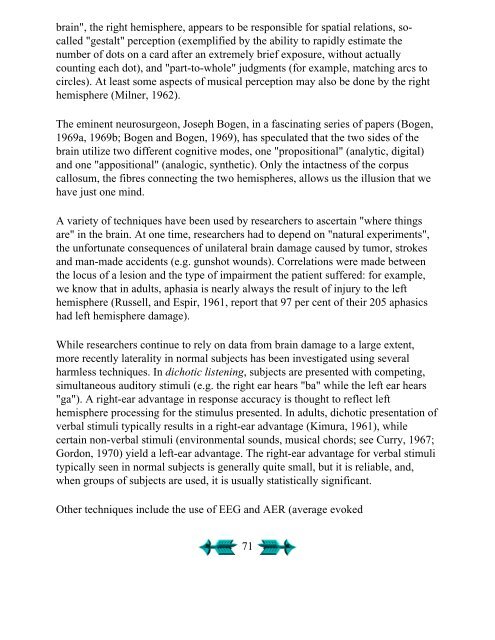Second Language Acquisition and Second ... - Stephen Krashen
Second Language Acquisition and Second ... - Stephen Krashen
Second Language Acquisition and Second ... - Stephen Krashen
Create successful ePaper yourself
Turn your PDF publications into a flip-book with our unique Google optimized e-Paper software.
ain", the right hemisphere, appears to be responsible for spatial relations, socalled<br />
"gestalt" perception (exemplified by the ability to rapidly estimate the<br />
number of dots on a card after an extremely brief exposure, without actually<br />
counting each dot), <strong>and</strong> "part-to-whole" judgments (for example, matching arcs to<br />
circles). At least some aspects of musical perception may also be done by the right<br />
hemisphere (Milner, 1962).<br />
The eminent neurosurgeon, Joseph Bogen, in a fascinating series of papers (Bogen,<br />
1969a, 1969b; Bogen <strong>and</strong> Bogen, 1969), has speculated that the two sides of the<br />
brain utilize two different cognitive modes, one "propositional" (analytic, digital)<br />
<strong>and</strong> one "appositional" (analogic, synthetic). Only the intactness of the corpus<br />
callosum, the fibres connecting the two hemispheres, allows us the illusion that we<br />
have just one mind.<br />
A variety of techniques have been used by researchers to ascertain "where things<br />
are" in the brain. At one time, researchers had to depend on "natural experiments",<br />
the unfortunate consequences of unilateral brain damage caused by tumor, strokes<br />
<strong>and</strong> man-made accidents (e.g. gunshot wounds). Correlations were made between<br />
the locus of a lesion <strong>and</strong> the type of impairment the patient suffered: for example,<br />
we know that in adults, aphasia is nearly always the result of injury to the left<br />
hemisphere (Russell, <strong>and</strong> Espir, 1961, report that 97 per cent of their 205 aphasics<br />
had left hemisphere damage).<br />
While researchers continue to rely on data from brain damage to a large extent,<br />
more recently laterality in normal subjects has been investigated using several<br />
harmless techniques. In dichotic listening, subjects are presented with competing,<br />
simultaneous auditory stimuli (e.g. the right ear hears "ba" while the left ear hears<br />
"ga"). A right-ear advantage in response accuracy is thought to reflect left<br />
hemisphere processing for the stimulus presented. In adults, dichotic presentation of<br />
verbal stimuli typically results in a right-ear advantage (Kimura, 1961), while<br />
certain non-verbal stimuli (environmental sounds, musical chords; see Curry, 1967;<br />
Gordon, 1970) yield a left-ear advantage. The right-ear advantage for verbal stimuli<br />
typically seen in normal subjects is generally quite small, but it is reliable, <strong>and</strong>,<br />
when groups of subjects are used, it is usually statistically significant.<br />
Other techniques include the use of EEG <strong>and</strong> AER (average evoked<br />
71











